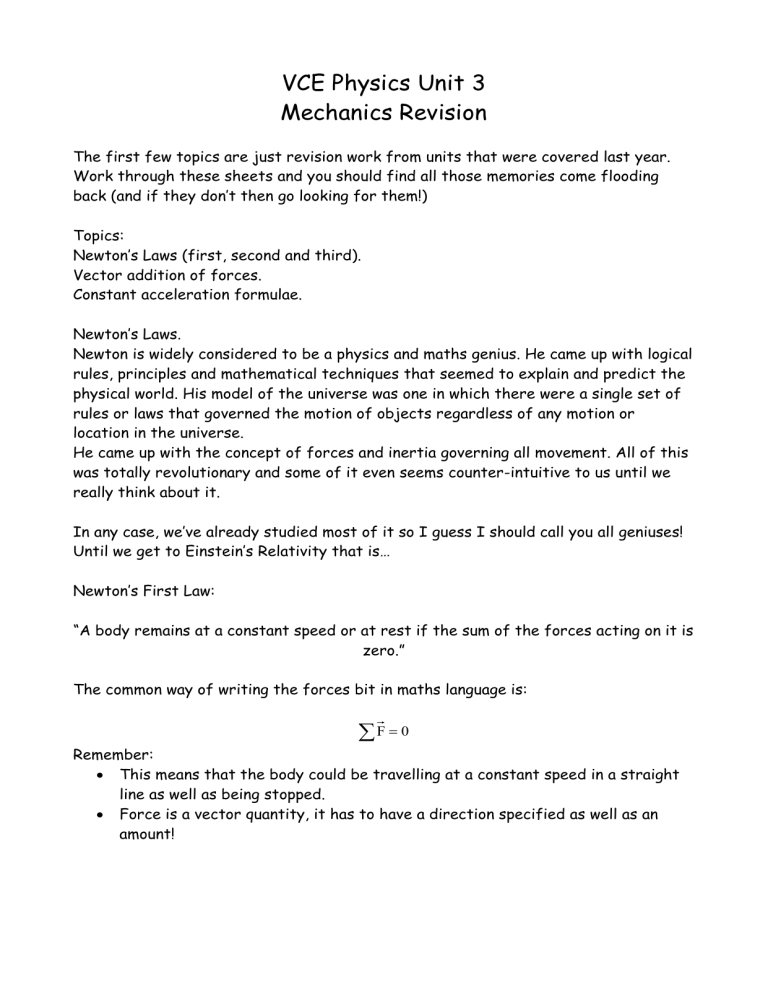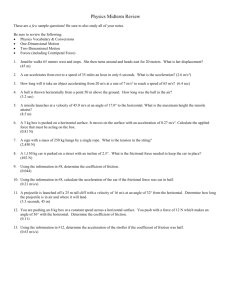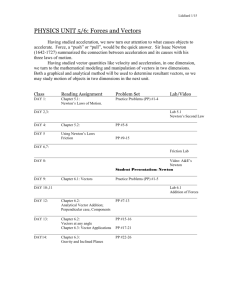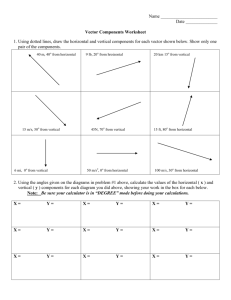VCE Physics Unit 3 Mechanics Revision

VCE Physics Unit 3
Mechanics Revision
The first few topics are just revision work from units that were covered last year.
Work through these sheets and you should find all those memories come flooding back (and if they don’t then go looking for them!)
Topics:
Newton’s Laws (first, second and third).
Vector addition of forces.
Constant acceleration formulae.
Newton’s Laws.
Newton is widely considered to be a physics and maths genius. He came up with logical rules, principles and mathematical techniques that seemed to explain and predict the physical world. His model of the universe was one in which there were a single set of rules or laws that governed the motion of objects regardless of any motion or location in the universe.
He came up with the concept of forces and inertia governing all movement. All of this was totally revolutionary and some of it even seems counter-intuitive to us until we really think about it.
In any case, we’ve already studied most of it so I guess I should call you all geniuses!
Until we get to Einstein’s Relativity that is…
Newton’s First Law:
“A body remains at a constant speed or at rest if the sum of the forces acting on it is zero.”
The common way of writing the forces bit in maths language is:
F
0
Remember:
This means that the body could be travelling at a constant speed in a straight line as well as being stopped.
Force is a vector quantity, it has to have a direction specified as well as an amount!
Newton’s Second Law:
“If a body experiences an unbalanced force it will accelerate by an amount proportional to the amount of force and inversely proportional to the mass.”
We usually see this written as:
F
m a
Remember:
Accelerate can mean speed up, slow down and/or change direction.
The bigger the force, the bigger the acceleration.
The bigger the mass, the smaller the acceleration.
Newton’s Third Law:
“For every force on object B by object A there is an equal (in magnitude) but opposite (in direction) force on object A by object B.”
We usually write this shorthand as:
F
AB
F
BA
Remember:
The forces are NOT on the same object, otherwise nothing could move!
The two objects will not usually have the same mass, so the resultant accelerations are often very different depending on the masses involved.
Solving problems using Newton’s Laws…
There are a few simple steps to follow when answering questions about forces and masses and accelerations.
1.
Draw a free body diagram showing the forces acting on the object. Make sure you include any angled forces and make sure you get the angles right!
2.
Label all of your forces etc, make sure you include the units. If you’re labelling a force be really clear to make it in Newtons. If you’re labelling a mass, be really sure that you put kg next to it. Accelerations should have a ms -2 or a m/s 2 . Try to keep all of your units in SI (m, s, kg, N etc.) and convert if you need to.
3.
Many examples involving forces at an angle require you to resolve the vectors into two components. If you do this, try doing the components in a different colour to help you remember what you’ve done.
4.
After you’ve done all of the setting up you’ll find the rest of the problem easy!
Just add vectors pointing in the same direction and subtract them if they are pointing the other way. Before you do this, MAKE SURE YOU HAVE
RESOLVED THEM!! Make sure you’ve got any diagonal vectors split into horizontal and vertical! In other words you should get two answers, one for the horizontal, one for the vertical.
5.
Your answer will need both a magnitude and direction. Draw your two answers and then work out the length of the resultant using Pythagoras (c 2 = a 2 + b 2 ) then work out the angle using trig.
Worked example:
A toy truck of mass 500g is being pulled by two children. The first child pulls with a force of 5N, the second with a force of 3N in the opposite direction. What acceleration will the truck have?
Diagram:
Note that the 500g has been changed to the SI value of 0.5 kg.
Because there are no angles, we don’t need to do any vector resolution. Simply add the vectors together:
5N + (–3N) = 2N
Notice that there is a minus sign in front of the 3N force. This indicates that it is in the opposite direction to the 5N force.
Now we need to calculate the actual acceleration. We can do this because we know the sum of the forces and the mass of the object, so we can use Newton’s Second
Law.
F =
2N = a =
Ma
0.5kg x a
4 m/s 2
Okay, let’s look at an example with some degree of difficulty in it. Same as before, but now the children are pulling at different angles. Let’s say that the 5 N force is at
60 degrees to the horizontal, the 3 N force at 10 degrees to the horizontal in the opposite direction.
Okay, remember that before we do any adding etc. we have to RESOLVE the vectors!
Let’s look at the 3 N force first. We need to use some trigonometry. To find the vertical component we use: vertical component
3 x sin( 10
) vertical component
0 .
52
Now we need to also find the horizontal component.
N horizontal component horizontal component
Repeating for the 5 N force gives us:
3 x cos( 10
)
2 .
95 N vertical component vertical component
5 x sin( 60
)
4 .
33 N and horizontal component horizontal component
5 x cos( 60
)
2 .
5 N
Now we should draw the picture again, with our resolved vectors. I suggest using different colours or something to help you see what is going on more clearly.
Now we can just add up the forces, remembering that we’ll have two answers, one for the horizontal, one for the vertical:
Horizontal: 2.5 N + (-2.95 N) = -0.45 N
Vertical: 4.33 N + 0.52 N = 4.85 N
The minus sign on the horizontal tells us that it is going to the left since we used the right vector as the positive one.
So, now we can re-draw our picture, with our vectors added up.
Start by drawing the horizontal, then draw the vertical so that it starts where the horizontal finishes:
Now we can work out the single resultant vector that these two will give us (not forgetting to do the angle as well of course).
Magnitude:
Resultant 2 = 4.85
2 + (-0.45) 2 (be careful here, these numbers should both be positive in the end, be careful with your calculator.)
Resultant 2 = 23.725
Resultant = 4.87 N
And the angle: tan(
)
opposite
adjacent
4 .
85
0 .
45
tan
1 (
4 .
85
0 .
45
)
85
So the final step is to calculate the acceleration and write our answer:
F = ma. 4.87 N = 0.5 kg x a a = 9.74 m/s 2
So the truck will accelerate at 9.74 m/s 2 to the left at an angle of 85 to the horizontal.
Phew, done! Although it seems like a lot of working out and stuff, when you get the hang of it you’ll find it really quite simple.
Just DRAW it!
Diagram!
Resolve!
Add!
Work out!
Okay, let’s move on to another question.
A 1500 kg car rests on a 30 to the horizontal hill. The parking brake is released.
Assuming no friction, with what acceleration will it move down the slope?
(Try this one yourself, there’s a long way to do it and a shortcut.)
Constant acceleration formulae.
You remember these!
x
v
1
( u
2 u
at
v ) t x
ut
1
2 at 2 x
vt u 2
1 at 2 v 2
2
2 ax
Make sure that when you use these formulae that you are NOT using average values.
These are for constant acceleration motion at a particular time (t).





